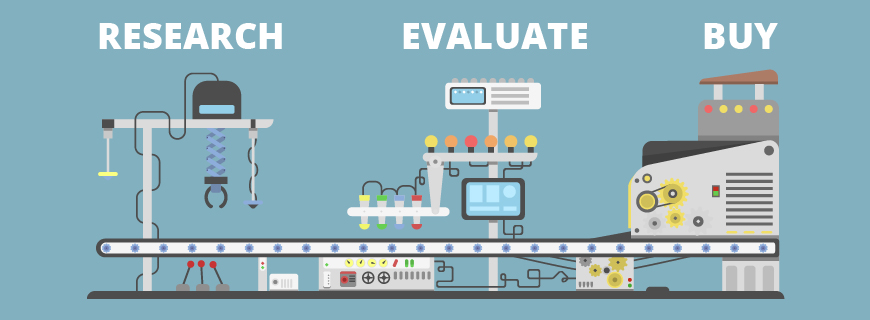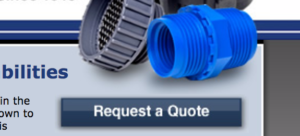
Unless you’re selling a commodity product, you’re probably no stranger to a complex industrial buying process. And of course, that’s because what you sell is complex too.
In fact, if you’re anything like most of our industrial sector clients, you’re just as much a consultant and educator of your customers and leads as you are a president, marketing director or salesperson. Your job involves listening, learning and understanding the problems your buyer needs to solve before the conversation about buying even begins.
You don’t sell widgets, but smart solutions to tough problems that require building relationships and cultivating trust. And the process of buying that kind of thing is nothing short of complex.
In this article, we’ll first look at three characteristics of the industrial buying process that foster complexity:
- Your customers aren’t companies, but real people
- Your customer isn’t one person, but many
- Big purchases don’t happen overnight, but over time
Next, I’ll introduce a powerful solution that will help you face the complex industrial buying process head on – content marketing. We’ll look both at the role content marketing plays in the industrial buying process and how content should align with the different stages of your buyer’s journey.
Finally, I’ll send you on your way with two assignments to help you kickstart a content marketing strategy for your business, and I’ll point you toward a few great resources to help you along the way.
Let’s get started!
Three important characteristics of the industrial buying process
1. Your customers aren’t companies, but real people
Sometimes it’s easy to forget who’s on the other end of your trade journal ads, mailers, website content and company newsletters. Your buyers are people – real, live, human people with their own jobs to do and their own problems to solve. These real people must be the focus of your industrial marketing strategy.
2. Your customer isn’t one person, but many
Step outside your business environment for a minute and picture yourself answering a call from one of your good buddies. How did you say hello? What’s the topic of the conversation? What’s your tone? What kind of words are you using?
Mid conversation you glance down and see another incoming call. It’s your five-year old niece Suzie and she wants to video chat. You can’t bear to wind up in her dog house, so you tell your buddy you have to run and immediately shift dialogue from this weekend’s fantasy football matchup to princesses and fairies. How does your tone change this time? And your choice of words?
After a few minutes, Suzie hears the ice cream truck and you’re suddenly an afterthought. That’s probably a good thing since you’ve got a handful of important emails from your boss to answer. Medium, tone, content and selection of words all change again, right?
Now let’s travel back to your world of industrial marketing and sales.
Just as Best Buddy, Little Suzie and Bossman are all very different real live people who require very different styles of communication, your customers, leads and prospects do as well. On a regular basis, you and your company are pitted against an army of questioners defending themselves against your sales pitch. That army is comprised of design engineers, procurement folks, plant managers, CEOs, CFOs, COOs, CIOs and maybe a few other C-something-Os that haven’t even surfaced yet.
Each cares about the different things, consumes information in different ways, speaks in his/her own voice, faces his/her own unique challenges and strives to achieve his/her own individual goals. Each requires your attention, but each is different. That means one-size-fits-all marketing won’t cut it.
3. Big purchases don’t happen overnight, but over time
If you’re nodding your head so far, then I imagine you’re also used to a buying process measured not in minutes, hours or days, but instead, in weeks, months or years.
The best salespeople understand how that long buying process works. And if you have a few of those salespeople working with you (or if you happen to be one yourself), I’m sure they’ve catered their selling process accordingly. But for some mysterious reason, this long-buying-process mindset rarely carries over to the marketing strategies these same companies deploy.
In fact, I’m willing to bet that more than 90% of the company websites of manufacturing professionals who read this article have one single call-to-action on their website. And it either looks like this:

Or like this:

Stop to think about that for a second. The sales cycle takes weeks or months or years. But the only call-to-action on the website asks a visitor to buy something right now.
Seems a little bit backwards, doesn’t it?
At the time I’m writing this article, it’s 2017, but I drive a 2003 Camry. Yes, it’s true.

There she is in my driveway. A beaut, wouldn’t you say?
I know that one of these mornings, I’ll rush out the door for an important meeting and Ol’ Reliable won’t start. And because I’m a fairly rational guy, I’ve been in the car-buying mindset for a few years. So, do you think my first move after I first started contemplating my trusty Camry’s mortality was to walk into a car dealership and say, “I’m here! Start selling to me!”?
No sir.
But here’s what I have been doing for quite a while:
- Observing every mid-sized SUV equipped to comfortably carry two car seats and all the other stuff that comes with a couple little kiddos
- Reading Car and Driver comparisons online to self-educate
- Talking to friends about their car-buying experiences
- Google searching things like “Ford Explorer vs. Toyota Highlander”, “best midsize SUVs” and “how to outsmart a sleazy car salesman who thinks he’s gonna get the best of me but doesn’t know what’s he’s got coming”
If I do the car thing the same way this next time around, I’ll be driving that SUV until at least 2031. So I’m damn well not reading the CliffsNotes before I make this purchase! Instead, I’m putting in the time to educate myself and learn. Then, I’ll go talk to the car salesman, informed and ready to tell him what I want and how much I know it’s worth. Watch out, car salesman.
Here’s the thing. Your buyers are no different. I don’t care if they’re Engineers or Procurement Managers or CEOs. Like we discussed earlier, they’re all humans. And because they’re probably smart humans, they’re doing their homework too.
IEEE Engineering 360’s 2016 Industrial Buy Cycle Study found that the length of the typical industrial buying cycle stages are as follows:
- Research and Needs Analysis: 4.5 weeks
- Comparison and Evaluation: 3.9 weeks
- Purchase: 4.0 weeks
The reality is that your prospective customers don’t want get on the phone and listen to your sales pitch until they’re ready to get on the phone and listen to your sales pitch. Until that time comes, they’re steering clear of your website’s Request a Quote button. And they’re glancing right over your $5000 “Hey we’re amazing and you should definitely hire us” trade journal ad you’ve been running every month for the last ten years.
The bottom line is that decisions involving real people, multiple people and long timelines are usually associated with significant financial investments and important consequences that naturally require extensive research, comparison and evaluation.
Manufacturers need to embrace this reality and think about their marketing communications differently, or any kind of marketing investment they make will amount to nothing short of a waste of their time and money.
Enter content marketing.
Content marketing and its role in the industrial buying process
This long, complex, consultative industrial sales process you know so well happens to have a marketing counterpart. It’s called content marketing. And the rest of this article serves as an introduction, paired with action steps for you to put this practice in motion for your organization.
As defined by marketing thought leader Joe Pulizzi of the Content Marketing Institute,
“Content marketing is a strategic marketing approach focused on creating and distributing valuable, relevant, and consistent content to attract and retain a clearly-defined audience — and, ultimately, to drive profitable customer action.”
Content marketing is about teaching your prospective customers and helping them take a step forward in their buying processes. It’s about answering their common questions, helping them solve problems and illustrating potential solutions. Content marketing exists not to replace the consultative sales process, but to support it. Great content will attract more-qualified prospects in greater volumes, begin to earn their attention and trust and prompt real sales conversations that you would not have otherwise been afforded.
No marketing approach makes more sense for an industrial company selling complex solutions to multiple people over an extended period of time.
How content aligns with the industrial buyer’s journey
Here’s a simplified representation of the complex industrial buyer’s journey:

And here’s how (and where) most manufacturers deploy marketing communications to their prospective customers along that journey:

But here’s how (and where) manufacturers should be deploying those marketing communications:

And really, a separate timeline like this should exist for each of your buyer personas, to match the differing needs of each along their respective buying journeys.
As you see above, content can exist in many forms. A few examples include the following:
Educational articles
Educational articles or blog posts (like the one you’re reading right now) help your prospective customers discover you in search engines, trade journals, social media networks or other online publishing platforms. These articles help educate your visitors, familiarize them with your organization and prompt them to say, “Huh – these guys are pretty smart. And they really seem to understand my challenges.” Here are a few examples of educational articles by industrial companies:
- Why sustainable plastics?
- Telescopic boom truck advantages vs. knuckle boom cranes
- GHS compliant labels and cost-effective GHS label printing
Gated white papers, E-Books and downloadable guides
More comprehensive, premium white papers and guides that require the submission of contact information in exchange for the content allow you to generate real leads from your website visitors. These premium types of content offer enough value to your prospective customers that they’re willing to trade you their names, email addresses and phone numbers. This exchange forms the foundation of an inbound lead pipeline for your sales team. Here are few examples of downloadable, form-gated content by industrial companies:
- Heat Treating 101: An Introduction to Heat Treating Procedures
- The OEM’s Guide to Industrial Coatings
- Final Tier 4 Regulations Guide
Tutorial videos
Putting a real face on camera adds a human element to your content. Remember – your buyers are real people. They want to know that you’re one too.
Case studies
Case studies demonstrate that you walk the walk. They serve to qualify your business as a potential solution for your prospective customers once they’ve done the preliminary research in their respective buying processes.
Beginning your organization’s content marketing journey
If you’ve made it this far, hopefully some of what you’ve read has resonated and that you’re beginning to formulate a vision for how content marketing could work for your business. Here’s are the first two steps I recommend to get started.
1. Identify and document your buyer personas
Everything begins with your buyer. So start by picturing your perfect customer. Who is that company? And who are those individuals who play a role in the buying process? Design Engineers? Procurement Managers? CEOs?
Just knowing who they are is not enough. You’ll want flesh out buyer persona profiles for each in writing, share them with everyone at your organization who plays a role in attracting and acquiring new business and reach an agreement as a team that these are indeed accurate descriptions of your ideal buyers.
For more guidance on how to write your targeted manufacturing buyer persona profiles, read this article.
2. Create that first piece of content
Beginning the work is always easier said than done. But you need to start somewhere. You’ve identified your buyer personas, you’ve identified what they need to learn and understand before they buy from you. Now it’s time to teach them.
So choose one buyer persona, one common question that buyer tends to ask during his buying process, and write a comprehensive answer. Remember that you’re teaching – not selling. You should of course conclude your article with a call-to-action, like asking the reader to request a free consultation with one of your company’s experts. But aside from that, your job is to teach.
Once you’ve published your first piece of content on your website, I’m confident you’ll feel both a sense of accomplishment and relief. Your next piece will come much more easily, as will each that follows. Simply getting started is the biggest hurdle you’ll face.
Some content marketing resources to help you keep learning
Thankfully, so much great free content can be found online about about, well, creating content. This guide by Moz is a good place to start: The Beginners Guide to Content Marketing.
I also strongly recommend the following three books, and in this order.
- Start with They Ask You Answer by Marcus Sheridan because you won’t be able to put it down. Marcus demonstrates the power of content marketing through real-life case studies that have transformed businesses and the lives of the people who run them. If this one doesn’t inspire you, I formally give you permission to keep running those $5000/month print ads!
- Content Inc. by Joe Pulizzi will teach you how to build a targeted, engaged and qualified audience of prospective customers by becoming the greatest teacher in your space.
- Everybody Writes by Anne Handley will coach you on how to be a writer when you’re not a writer so you’ll be less intimidated about getting started.
On that note, it’s time to go get started! Don’t wait until next week or next month. The sooner you begin, the sooner you’ll begin attracting the right buyers and booking more calls with sales-qualified leads.
If you want investigate how buyer personas and content marketing fit specifically into the bigger industrial marketing picture, read our Industrial Marketing: The Definitive Guide. Or if you’d like to chat about how to bring all of this to life for your B2B industrial company, consider requesting a consultation with one our Industrial Marketing Strategists.
Thanks for reading and good luck getting up and running!

Learn how to grow your business online.
Our free Industrial Marketing Guide will show you how to attract qualified website visitors, convert them into real leads and nurture them through the buying process.